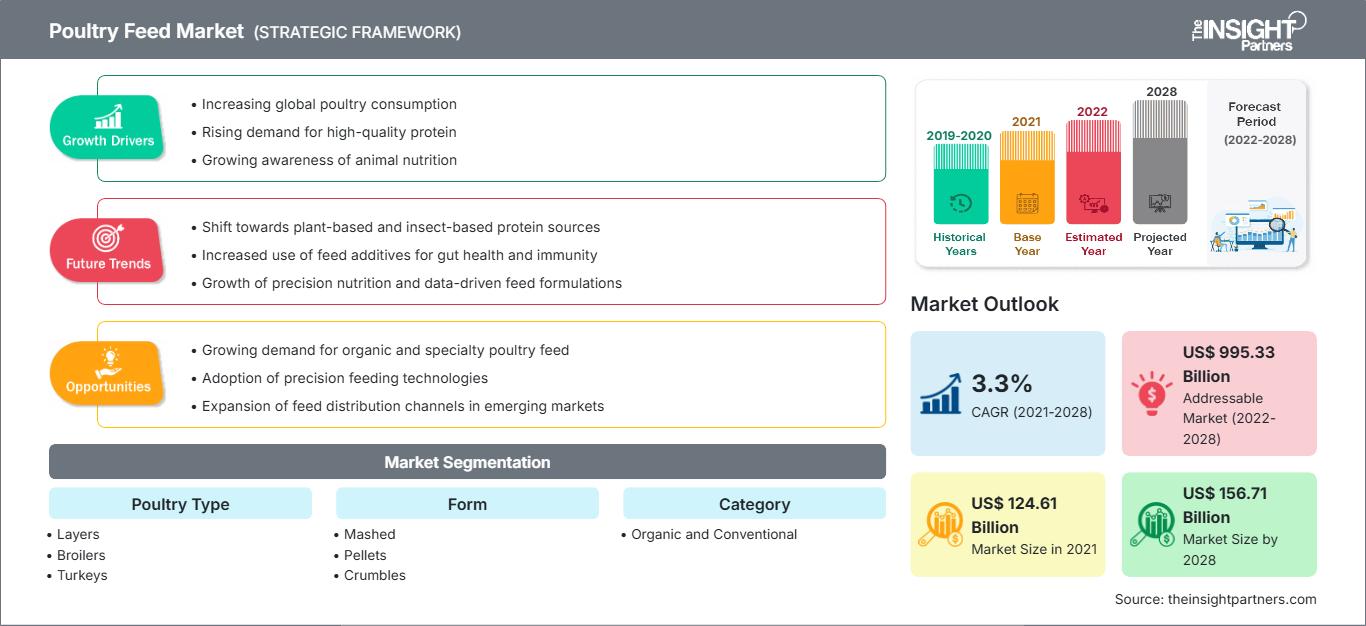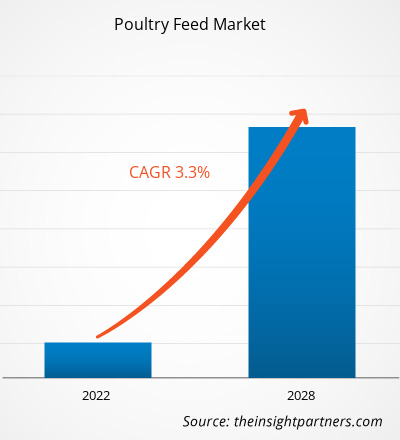Il mercato dei mangimi per pollame è stato valutato a 124.611 milioni di dollari nel 2021 e si prevede che raggiungerà i 156.710 milioni di dollari entro il 2028; si prevede una crescita a un CAGR del 3,3% dal 2021 al 2028.
I mangimi per pollame sono prodotti a partire da diverse materie prime, come cereali e granaglie, panelli o farina oleosa e additivi per mangimi. I requisiti nutrizionali dei mangimi per pollame dipendono dal peso e dall'età del pollame, dal suo tasso di crescita e dal tasso di produzione di uova. L'aumento del consumo di prodotti avicoli tra i consumatori sta dando impulso al mercato dei mangimi per pollame. Nel 2020, l'area Asia-Pacifico ha detenuto la maggiore quota di fatturato del mercato globale dei mangimi per pollame. Con un'ampia base di consumatori di carne di pollame, il mercato dei mangimi per pollame dell'area Asia-Pacifico sta registrando una crescita notevole e si prevede che continuerà a farlo nei prossimi anni. Cina e India sono i due principali produttori di mangimi per pollame al mondo. In India, il settore della produzione di mangimi per pollame è tra quelli in più rapida crescita, con una concorrenza sempre più serrata tra i produttori di mangimi. I consumatori di questa regione sono alla ricerca di ulteriori fonti di alimenti ricchi di proteine. L'aumento della domanda di alimenti ricchi di proteine, unito all'aumento del potere d'acquisto, ha alimentato ampiamente il consumo di carne di pollame. È probabile che tutti questi fattori alimenteranno la crescita del mercato dei mangimi per pollame nell'area Asia-Pacifico durante il periodo di previsione.
Personalizza questo rapporto in base alle tue esigenze
Potrai personalizzare gratuitamente qualsiasi rapporto, comprese parti di questo rapporto, o analisi a livello di paese, pacchetto dati Excel, oltre a usufruire di grandi offerte e sconti per start-up e università
Mercato dei mangimi per pollame: Approfondimenti strategici

- Ottieni le principali tendenze chiave del mercato di questo rapporto.Questo campione GRATUITO includerà l'analisi dei dati, che vanno dalle tendenze di mercato alle stime e alle previsioni.
Impatto della pandemia di COVID-19 sul mercato dei mangimi per pollame
Potrai personalizzare gratuitamente qualsiasi rapporto, comprese parti di questo rapporto, o analisi a livello di paese, pacchetto dati Excel, oltre a usufruire di grandi offerte e sconti per start-up e università
Mercato dei mangimi per pollame: Approfondimenti strategici

- Ottieni le principali tendenze chiave del mercato di questo rapporto.Questo campione GRATUITO includerà l'analisi dei dati, che vanno dalle tendenze di mercato alle stime e alle previsioni.
L'attuale pandemia di COVID-19 ha imposto l'attuazione di misure preventive che hanno drasticamente alterato lo stato dell'industria dei mangimi per animali e hanno avuto un impatto negativo sulla crescita del mercato dei mangimi per pollame. I governi di tutto il mondo hanno ordinato la chiusura dei loro porti internazionali, causando ulteriori interruzioni nella catena di approvvigionamento dei mangimi per pollame. La pandemia di COVID-19 ha avuto un impatto sulla disponibilità di materie prime per la preparazione dei mangimi per pollame in quasi tutti i paesi. Mais e soia sono gli ingredienti principali dei mangimi per pollame. Molti paesi in tutto il mondo che dipendono dalle importazioni di queste materie prime per la preparazione dei mangimi per pollame hanno avuto notevoli problemi nell'approvvigionamento degli ingredienti. La disponibilità di mangimi per pollame nella maggior parte dei luoghi è stata difficile a causa della chiusura degli stabilimenti di produzione di mangimi. Il consumo mondiale di carne di pollame è diminuito drasticamente. L'industria dei mangimi per pollame è stata gravemente colpita dalla chiusura dei ristoranti in tutto il mondo. Tuttavia, poiché le economie stanno pianificando di riprendere le loro attività, si prevede che la domanda di mangimi per pollame aumenterà a livello globale. Si prevede che la crescente domanda di mangimi per pollame e gli investimenti significativi da parte di importanti produttori guideranno la crescita di questo settore.
Approfondimenti di mercato
La crescente produzione di pollame
Alimenta la crescita del mercato dei mangimi per pollame
Il settore avicolo sta registrando una continua crescita in tutto il mondo. Il pollame è considerato una delle fonti proteiche più convenienti, grazie alla quale la domanda di prodotti avicoli, come uova e carne, continua ad aumentare. Si registra un'impennata nel consumo di pollo tra le persone più attente alla propria salute. L'aumento della produzione avicola sta rispondendo in modo sostanziale al crescente fabbisogno della popolazione mondiale. Secondo l'Organizzazione per l'alimentazione e l'agricoltura (FAO) degli Stati Uniti, la produzione mondiale di carne di pollame è aumentata da 9 a 132 milioni di tonnellate tra il 1961 e il 2019, mentre la produzione di uova è cresciuta da 15 a 90 milioni di tonnellate. La crescente produzione di pollame promuove l'utilizzo di mangimi di qualità.
Approfondimenti sulla tipologia di pollame
In base alla tipologia di pollame, il mercato globale dei mangimi per pollame è segmentato in ovaiole, polli da carne, tacchini e altri. Il segmento dei polli da carne ha detenuto la quota maggiore del mercato nel 2020. I polli da carne sono polli allevati per la carne e vengono alimentati con una dieta ricca di proteine per favorirne una rapida crescita. Il mangime per polli da carne è disponibile in diverse forme, come pastone, pellet e sbriciolato. L'India è uno dei maggiori produttori di polli da carne, con una crescente domanda di mangimi composti nel settore. La crescente produzione di polli da carne continuerà ad aumentare la domanda di mangimi per pollame da carne durante il periodo di previsione.
Approfondimenti sulla forma
In base alla forma, il mercato globale dei mangimi per pollame è segmentato in pastone, pellet, sbriciolato e altri. Il segmento dei pellet ha detenuto la quota di mercato maggiore nel 2020. Il mangime in pellet viene prodotto utilizzando vapore e pressione per comprimere il mangime in poltiglia. Il mangime in poltiglia viene compresso e modellato in pellet duri e asciutti in una pressa per pellet. Il mangime in pellet migliora il tasso di crescita nei polli da carne con un aumento dell'assunzione di mangime. Ciò è dovuto alla maggiore digeribilità, alla minore segregazione degli ingredienti e alla maggiore appetibilità. Poiché gli ingredienti sono ben miscelati in ogni pellet, il mangime in pellet garantisce una dieta ben bilanciata, una migliore conversione alimentare e prestazioni negli uccelli da cortile. I vantaggi del mangime in pellet, come la facile digeribilità, una dieta ben bilanciata e meno sprechi, contribuiscono solitamente alla sua elevata domanda.
Alcuni attori chiave nel mercato globale dei mangimi per pollame sono ADM; Cargill, Incorporated; Alltech; Charoen Pokphand Foods PCL; For Farmers; Kent Corporation; SHV Holdings; Land O'Lakes, Inc.; AFGRI Animal Feeds; e DE HEUS ANIMAL NUTRITION. Gli operatori del mercato sono fortemente concentrati sullo sviluppo di offerte di prodotti innovativi e di alta qualità per soddisfare le esigenze del cliente.
Mercato dei mangimi per pollame
Mercato dei mangimi per pollame
Le tendenze regionali e i fattori che influenzano il mercato dei mangimi per pollame durante il periodo di previsione sono stati ampiamente spiegati dagli analisti di The Insight Partners. Questa sezione illustra anche i segmenti e la geografia del mercato dei mangimi per pollame in Nord America, Europa, Asia-Pacifico, Medio Oriente e Africa, America Meridionale e Centrale.
Ambito del rapporto sul mercato dei mangimi per pollame
| Attributo del rapporto | Dettagli |
|---|---|
| Dimensioni del mercato in 2021 | US$ 124.61 Billion |
| Dimensioni del mercato per 2028 | US$ 156.71 Billion |
| CAGR globale (2021 - 2028) | 3.3% |
| Dati storici | 2019-2020 |
| Periodo di previsione | 2022-2028 |
| Segmenti coperti |
By Tipo di pollame
|
| Regioni e paesi coperti | Nord America
|
| Leader di mercato e profili aziendali chiave |
|
Densità degli operatori del mercato dei mangimi per pollame: comprendere il suo impatto sulle dinamiche aziendali
Il mercato dei mangimi per pollame è in rapida crescita, trainato dalla crescente domanda da parte degli utenti finali, dovuta a fattori quali l'evoluzione delle preferenze dei consumatori, i progressi tecnologici e una maggiore consapevolezza dei benefici del prodotto. Con l'aumento della domanda, le aziende stanno ampliando la propria offerta, innovando per soddisfare le esigenze dei consumatori e sfruttando le tendenze emergenti, alimentando ulteriormente la crescita del mercato.

- Ottieni il Mercato dei mangimi per pollame Panoramica dei principali attori chiave
In evidenza nel rapporto
- Tendenze progressive del settore nel mercato dei mangimi per pollame per aiutare gli operatori a sviluppare strategie efficaci a lungo termine
- Strategie di crescita aziendale adottate dai mercati sviluppati e in via di sviluppo
- Analisi quantitativa del mercato dei mangimi per pollame dal 2019 al 2028
- Stima della domanda globale di mangimi per pollame
- Analisi delle cinque forze di Porter per illustrare l'efficacia di acquirenti e fornitori che operano nel settore
- Sviluppi recenti per comprendere lo scenario competitivo del mercato
- Tendenze e prospettive di mercato, nonché fattori che guidano e frenano la crescita del mercato dei mangimi per pollame
- Assistenza nel processo decisionale evidenziando le strategie di mercato che sostengono l'interesse commerciale, portando alla crescita del mercato
- Le dimensioni del mercato dei mangimi per pollame in vari nodi
- Panoramica dettagliata e segmentazione del mercato, nonché le dinamiche del settore dei mangimi per pollame
- Dimensioni del mercato dei mangimi per pollame in varie regioni con promettenti opportunità di crescita
Mercato globale dei mangimi per pollame
Per tipo di pollame
- Pollaie
- Polli da carne
- Tacchini
- Altri
Per forma
- Pellet
- Briciole
- Altri
Per categoria
- Biologico
- Convenzionale
Profili aziendali
- ADM
- Cargill, Incorporata.
- Alltech.
- Charoen Pokphand Foods PCL
- ForFarmers
- Kent Corporation
- SHV Holdings
- Land O'Lakes, Inc.
- AFGRI Animal Feeds
- DE HEUS ANIMAL NUTRITION
- Analisi storica (2 anni), anno base, previsione (7 anni) con CAGR
- Analisi PEST e SWOT
- Valore/volume delle dimensioni del mercato - Globale, Regionale, Nazionale
- Industria e panorama competitivo
- Set di dati Excel
Report recenti
Rapporti correlati
Testimonianze
Motivo dell'acquisto
- Processo decisionale informato
- Comprensione delle dinamiche di mercato
- Analisi competitiva
- Analisi dei clienti
- Previsioni di mercato
- Mitigazione del rischio
- Pianificazione strategica
- Giustificazione degli investimenti
- Identificazione dei mercati emergenti
- Miglioramento delle strategie di marketing
- Aumento dell'efficienza operativa
- Allineamento alle tendenze normative






















 Ottieni un campione gratuito per - Mercato dei mangimi per pollame
Ottieni un campione gratuito per - Mercato dei mangimi per pollame